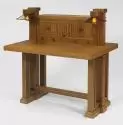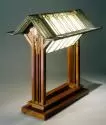A Mysterious Reproduction

George Mann Niedecken (1871-1945), while recognized as a significant Prairie School and Art Nouveau craftsman, skilled in the art of designing furniture, stained glass, lighting, tapestries, murals, and other furnishings. Born in Milwaukee, Wisconsin in 1871 he studied art at the Art Institute of Chicago, Berlin and in 1899 left for Paris to study at the Ecole-des-Beaux Arts working with Alphonse Mucha and being exposed to Art Nouveau. He may be best known for his collaborations with renowned American architect Frank Lloyd Wright between 1903 and 1918. These include the famed Avery Coonley and Frederick Robie homes built in the Chicago area between 1907-1910. Niedecken shared Wright’s familiarity with developments in European design and the commitment to simplicity, honest materials, and decorations derived from nature.
The table lamp (top photo) from the Edward P. Irving house, designed by George Mann Niedecken and manufactured by the Niedecken-Walbridge Company of Milwaukee, Wisconsin, is made from quarter sawn white oak, colored glass, and copper, measuring 24″ high by 23 ½” long by 15″ wide.
This is how David Cathers describes the lamp in the upcoming Arts & Crafts Lighting from the Collection of the Two Red Roses Foundation:
“An architectonic form with a footed, two-part rectangular oak base resting on mitered feet, and paired, spindle-shaped oak standards decorated at the top with sawn oak squares and triangles silhouetted against translucent white glass panels. These geometric motifs are restated in the fixture’s glass shade. Translucent, roof-like geometric leaded glass shade flanked by opaque leaded glass flanges; the stained glass has a hammered texture and some of the rectangular glass tiles are of double thickness. To diffuse and soften the light, the underside of the shade is enclosed within V-shaped leaded panels of translucent glass – repeating the “roof” profile in inverted form”.
This lamp has been displayed in a number of museums including the seminal exhibition International Arts and Crafts. Anchored at the Indianapolis Museum of Art, it traveled to the de Young – Fine Arts Museum of San Francisco and ended at the Victoria and Albert Museum in London. The lamp is also illustrated in The Western Architect (April 1913), Cheryl Robertson’s Frank Lloyd Wright and George Mann Niedecken – Prairie School Collaborators (1999), p. 46 and in Karen Livingstone and Linda Parry’s International Arts and Crafts (London: V & A Publications, 2005), p. 180.
Another important Niedecken acquisition is the Bresler Desk (bottom photo). This desk is an exact vintage replica (1908-1910) of the design by Frank Lloyd Wright in collaboration with George Niedecken, and produced for the Coonley House. The Coonley desk is currently in the collection of the Art Institute of Chicago. The Two Red Roses Foundation is not sure who built the Bresler desk in their own collection, but they know that Frank Bresler owned the F.H. Bresler Company, which made furniture for the Niedecken-Walbridge Company, and was also a minority stockholder in the latter firm. The Foundation speculates that Bresler liked the Coonley House desk design (he may have actually built it) and decided to make or have one made for his own house. Because The Foundation did not have the opportunity to review the extensive Niedecken collection of design drawings, documents, and other office records residing in the Milwaukee Art Museum Archives, they welcome input from any reader that may shed more light on the designer and maker of the Bresler Desk.
Click on over to our Facebook page’s top post to weigh in on this particular piece and share any insights you may have!

